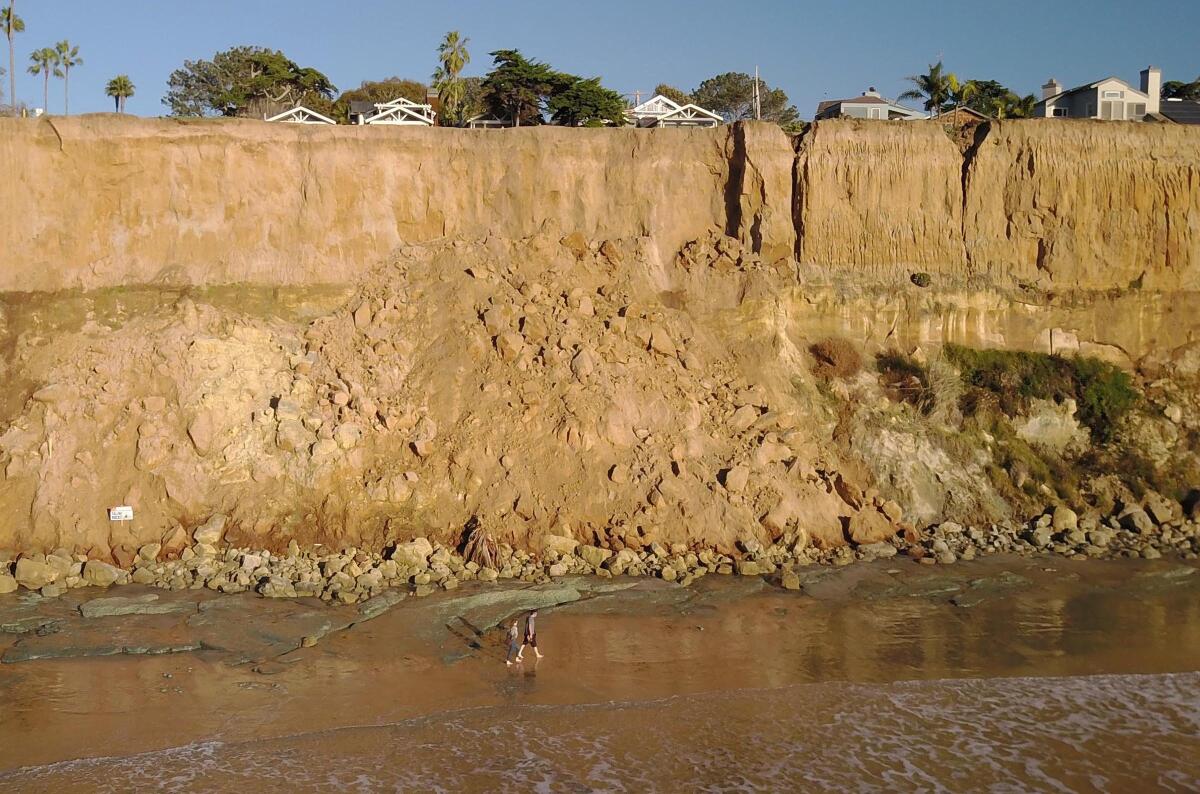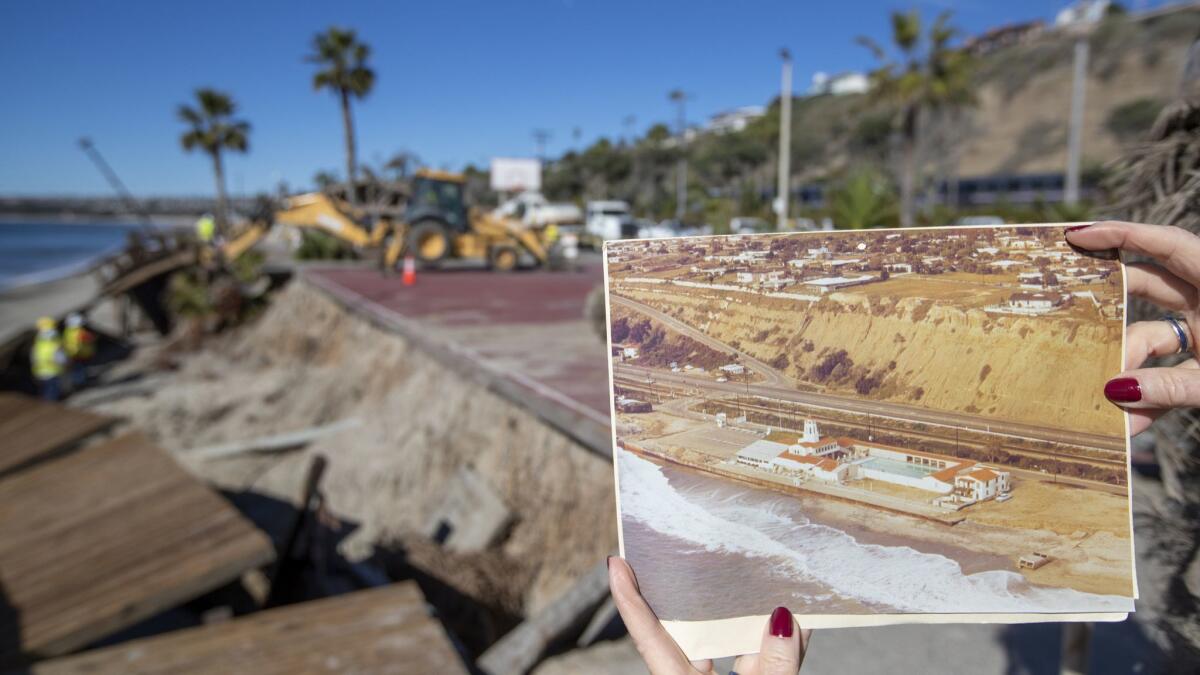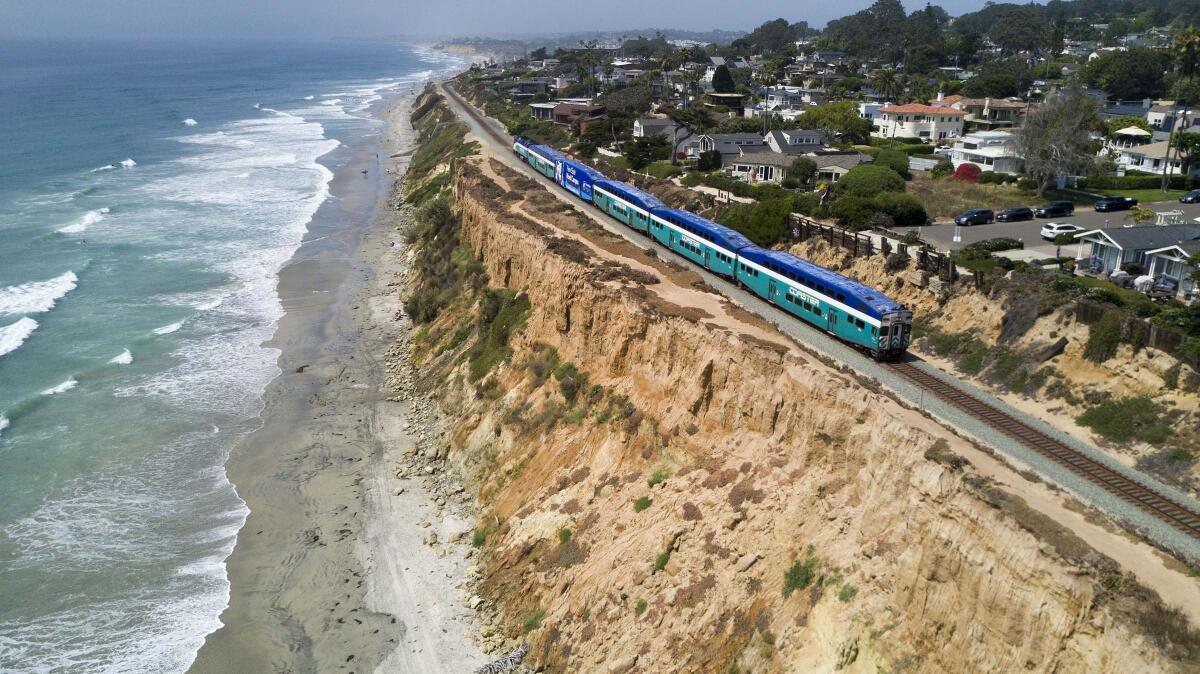Encinitas beach cliff collapse that killed 3 women part of larger California coast crisis

- Share via
The cliff collapse in Encinitas that killed three people Friday underscores the dangers of erosion on bluffs along the California coast.
Cliff erosion has long been a danger in San Diego County and other areas.
— In February, a landslide at Ft. Funston in San Francisco buried two women and a dog beneath the sand when the cliff where they were walking above the beach collapsed. Bystanders quickly pulled out one woman and her dog, and the woman was taken to a hospital with minor injuries. Another woman’s body was found in May.
— In 2017, a woman taking in the view on a cliff in Santa Cruz County fell to her death when the ground gave way beneath her. The woman was standing about a foot away from the edge and peering over the side when the cliff — battered by winter storms — collapsed.
— Last fall, sections of the cliffs in Del Mar collapsed three times in just a few weeks. Beachgoers had been cleared from the area, and there were no injuries.
Here is what we know from reports from The Times and San Diego Union-Tribune.
What happened Friday?

The Encinitas collapse happened about 2:55 p.m. on the beach just north of a mobile lifeguard tower and the wooden stairs leading to Grandview Beach from Neptune Avenue.
Encinitas lifeguard Capt. Larry Giles said a 30-foot-by-25-foot section of the bluff collapsed.
The collapse occurred near a popular surf spot known as Grandview. The sandy beach area changes with the tides but is generally very narrow.
A massive, hot-tub-size chunk of sandstone was among the debris that fell onto the sand below. Next to the detritus, beach chairs, towels and umbrellas were abandoned where the victims had set them up on a warm, partly cloudy day.
Brian Ketterer, southern field division chief with California State Parks, said the material in the collapse was dense Torrey and Del Mar sandstone.
“This material is very, very heavy,” he said. “Crews are going to come in and will slowly and meticulously break it apart to see if we have anybody still buried under there.”

Encinitas Fire Chief Mike Stein said emergency crews were unable to search portions of the debris because of the stability of the cliff. And complicating matters, the incoming tide Friday evening was expected to be among the highest of the year, Giles said.
Giles said his agency will post a lifeguard in the area and keep an eye on the site.
The captain said that the lifeguard tower near the scene was moved away from the area Saturday morning and that officials have determined that “the area is still active.” He said a geologist assessing the scene was “concerned about the areas to the side of the current failure failing.”
Has this been a recurring problem?
Yes, parts of the San Diego coast have been vulnerable to cliff erosion and collapse.
In 1995, two men died when they were buried under tons of rock, and another was injured as he fled, after a cliff at Torrey Pines State Beach collapsed. The two victims were sitting or walking on the beach when the cliff above them caved in. The men were covered by tons of rock and dirt.
The last fatal bluff collapse in San Diego County happened Aug. 20, 2008, when 57-year-old Nevada tourist Robert Mellone was crushed by a shower of sand and boulders from a section of bluff above Torrey Pines State Beach.
On July 17, 2002, a 39-year-old man, James Franklin, died when the cave he used for shelter at South Carlsbad State Beach collapsed on him.
Debate has gone on for decades about the causes of the cliff erosion and what to do about it, in Encinitas and other parts of San Diego. Research suggests it’s been going on for more than a century.
Where else are we seeing this?
Bluff and cliff erosion has been a problem along many popular beaches. Officials have been working to ease erosion at such popular spots as Palisades Park in Santa Monica and areas of Laguna Beach.
Capistrano Beach has been increasingly chipped away at by recent and past storms — as well as rising sea levels. Last week’s heavy rainfall eroded enough of the beach to expose the remains of old cars embedded in boulders filled with cement as part of a seawall built decades earlier.

In Southern California alone, cliffs could recede more than 130 feet by 2100 if the sea keeps rising, according to a study led by the U.S. Geological Survey.
Who died in Friday’s collapse?
The victims were part of the same family: a 35-year-old woman, her 65-year-old mother and her aunt. They were part of a large family gathering at Grandview Beach that day celebrating the aunt’s victory over breast cancer.
Riggins and Warth write for the San Diego Union-Tribune.
More to Read
Sign up for Essential California
The most important California stories and recommendations in your inbox every morning.
You may occasionally receive promotional content from the Los Angeles Times.













